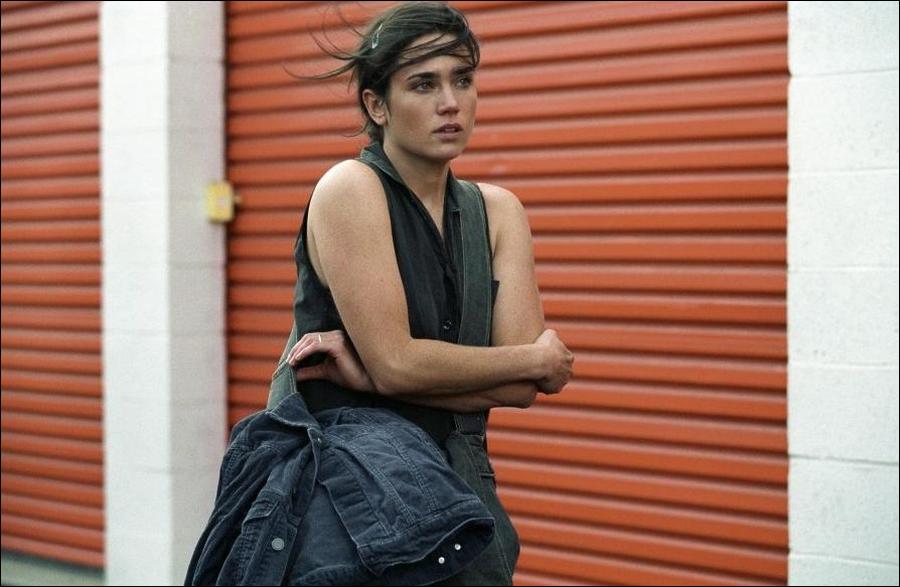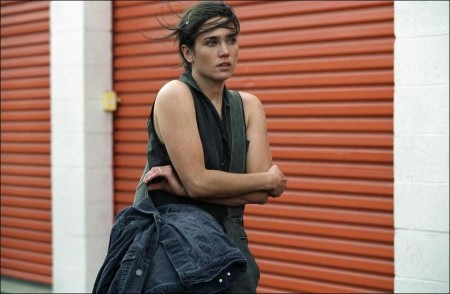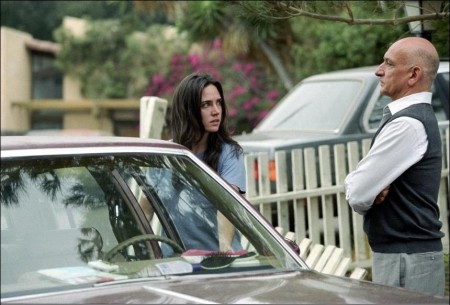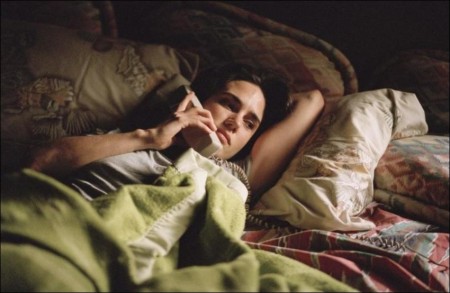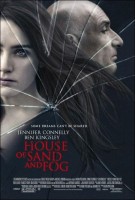Andre Dubus III’s book House of Sand and Fog was first published in 1999, telling the story of two desperate people—Massoud Amir Behrani, a once powerful and influential man in his native Iran reduced to menial jobs in the United States, and Kathy Nicolo, a recovering drug addict, with nowhere to turn—and their battle for ownership of a house, which threatens to destroy both of them.
The novel became an immediate sensation with book critics who praised its power and emotion, and it was also a Finalist for the prestigious National Book Award. Those early accolades propelled the book to a bestseller, but when Oprah Winfrey selected it for her Book Club, bringing Andre Dubus III on as a guest on her show, the novel became a runaway hit, topping all of the major bestseller lists.
Vadim Perelman, then a successful commercial director, was far from Hollywood when he first saw the book House of Sand and Fog on a bookrack at the Rome airport. He read it as he crossed the Atlantic, and by the time he landed, he knew his career had been set on a different course. “I knew I needed to tell this story,” he remembers. “It is a story about loneliness and of being cast out…about being an immigrant in a new country and, with regard to Kathy, about feeling like an immigrant in your own country. Those are themes that are primal and universal. Who could not relate to some aspect of that?”
Perelman can relate very personally to the immigrant experience. When he was in his teens, he and his mother left their home in the former Soviet Union behind. They lived hand-to-mouth in Vienna and Rome, before settling in Canada where they had to build a new life. Perelman would eventually cultivate a successful career in America as a commercial director, but those formative years gave him a keen understanding of Behrani’s pursuit of the American Dream and Kathy’s despair at having lost it.
It was that innate understanding of the book’s subject matter that convinced its author to award Perelman the film rights, despite his inexperience as a film director. Dubus recalls, “I had spoken to several people who were attracted to different elements of the story. When I spoke to Vadim, I sensed he understood the deeper resonance of the story…in some ways better than I did. He actually said things about the book that made me say, ‘That’s a good point. You’re right about that.’ Who knew?” he laughs. “He understood the importance of getting across the immigrant experience. I really felt he was going to be loyal to the story in its true form.”
“I remember being very passionate about telling the story,” Perelman says. “It propels you forward. You might have a hint of where it’s going, but I don’t think you are ever prepared for how it is going to end, and that’s the incredible power of this story.”
When Perelman sent Dubus the final draft of the screenplay, the author notes, “I loved it. It is so loyal to the book, how could I not love it? It was very impressive, and even I was moved by it, so I just knew I had made the right choice with Vadim.”
Producer Michael London was equally impressed with the screenplay. “You don’t often read a script that makes you say, ‘I have to produce this movie,’” he states. “I remember that by the time I put it down, I felt—like many of the people who ultimately took part in the movie—compelled to raise my hand and say, ‘I need to be involved in this.’ Every bone in my body was deeply affected by the story.”
London offers, “I think what the two central characters are after is something very fundamental: a home—literally a house and also figuratively a place to live and have a family—which Kathy has lost and Behrani is trying to hold on to. The thing these people are battling over is not cerebral, it’s not abstract, it’s very personal. Another thing I found so rich about the story is that you care about both of these people. There is no clear right and wrong. You believe that Kathy has been unfairly dislodged from her home, but you also become invested in Behrani’s struggle and his desire to give his family a better life. It defies any easy answers, and I believe that is where the ‘page-turner’ aspect of the movie kicks in.”
“One of the most important things I tried to achieve with this film is for people to root for Kathy and Behrani equally,” Perelman expounds. “They are both flawed people, but they both want something noble in a way. They don’t understand each other, though, and that is what will ultimately destroy them.”
Dubus agrees, “Their desires work against them. I think they both want this house so badly, it blinds them to the other’s motives. They prejudge each other terribly, the way, unfortunately, we tend to do with people from different classes and cultural backgrounds. When that’s the case, we are in dangerous territory.”
With a screenplay in hand, Perelman turned to casting the movie, beginning with the role of Colonel Massoud Amir Behrani. His first and only choice for the role was Ben Kingsley, but he soon learned that the book’s author was way ahead of him—or rather, the author’s wife, Fontaine Dubus, was. Perelman relates, “When I first contacted him about playing the part of Behrani, he told me he’d already read it. I asked, ‘You’ve read the script?’ and he said, ‘No, I read the book. Andre’s wife sent it to me right after it was published.”
Kingsley picks up the story. “She had taken it upon herself to send me the book with a very charming cover letter saying that her husband had written Behrani with a silhouette very similar to mine in mind. Not to say that he wrote it for me or about me, but that he used me as a kind of benchmark, if I may.
“I loved the book,” Kingsley continues, “and then, months later, Vadim sent me his beautiful screenplay. I felt Behrani was a man with whom I could empathize. I wanted to tell this man’s story. I was curious about his degree of commitment and his ability to endure loss and even humiliation in order to be the patriarch he feels he was born to be.”
“Ben was meant to play the role of Behrani; no one else could have even come close,” Perelman states. “Ben is the center, the rock of the movie. He is a great man as well as a brilliant actor…intuitive and wonderfully generous. I did not have to direct him because he didn’t need any direction; he simply embodied the character. Ben has a very regal bearing about him and a very proud demeanor, which was ideal for Behrani, who is proud, almost to a fault. Behrani has to work two menial jobs, which is demeaning to his core, but he will never show it. Even working on a road crew or at a convenience store, he carries himself like the Colonel he once was.”
“There are enormous forces that a human being can bring to bear to sustain, to accommodate, to understand, and to cope with loss,” Kingsley says. “We are extraordinary animals in our capacity to endure loss after loss after loss. To put it very briefly, Behrani is a man who lost his king, and then loses his kingdom, his son, his wife, his home and, finally, himself.”
Behrani is not the only one who suffers great loss. Loss is also the driving factor in the life of his adversary, Kathy Nicolo, in her fight to hold on to the one thing she has left in the world: her house. Jennifer Connelly, who stars as Kathy, remarks, “She is really lost at the beginning of the film. She has been left by her husband and had to overcome a drug addiction, and so now she is in her house, kind of hibernating, when she is wrongly evicted for non-payment of a tax she never owed. You come to understand, I think, why the house means so much to her, and why she is so stubbornly clinging to it.”
Connelly says that she was immediately interested in portraying Kathy after reading the script, which she describes as “moving and beautifully written,” adding, “I liked the fact that there is no good guy and bad guy. I found it really compelling that both sides do things that are morally questionable, because life is often like that.”
Not long after Connelly accepted the role, however, her own life changed dramatically. Michael London explains, “Jennifer committed to it right before she won the Academy Award® for ‘A Beautiful Mind,’ and she was immediately deluged. But she remained extraordinarily loyal to our project. I think she understood Kathy, and knew in her bones that she could take this character and give her the kind of dimension that she has. I don’t think there is another actress who could have played Kathy with such power and grace.”
Perelman is aware that “power” is a quality others might not have attributed to the role of Kathy, but counters, “Some people might interpret Kathy as a weak character, but I don’t think she is. She is caught in a whirlpool and is being pulled down and, like a drowning victim, she becomes more and more desperate. At that point of desperation, she starts grabbing at straws, grabbing at anything to get her house back in any way possible.” Connelly agrees. “Kathy is reaching for things to hold onto to keep her afloat, but they are things that are never going to be able to save her.”
At first, Kathy tries to regain ownership of her house with the help of legal aid attorney Connie Walsh, played by Frances Fisher. When legal channels fail her, Kathy reaches out to Lester Burdon, ironically the Deputy Sheriff she first met when he was sent to evict her from the house.
Perelman went through a rather long casting process to find the right actor to play Lester Burdon, but says that when he saw Ron Eldard, he knew he was perfect for the role. “I wanted somebody who could convey this incredible feeling of vulnerability, and also had a kind of off-kilter magnetism about him, and Ron was just right for both. He did a great job as Lester.”
Ron Eldard recalls that what immediate intrigued him about the drama was its unexpected twists and turns. “I remember reading it and wondering what was going to happen, and every time I thought I knew where it was going, it went somewhere else. It had a great thriller aspect to it.”
The actor also found it interesting that relatively small choices on the part of each character were enough to instigate shattering results. “The little decisions are often what matter most in life,” Eldard offers. “There are big things going on, but it’s those tiny little steps that turn the tide bit by bit.”
Lester’s own relationship with Kathy grows from his impulse to help a woman in need. “He sees that she needs help, and his heart opens up to her,” Eldard says. “Maybe it began as his instinctive reaction as a policeman to a person in trouble. He sees her as someone who is really vulnerable and on the verge of imploding. But his trying to protect her becomes a catalyst for much of what happens.”
“Lester idealizes the situation with Kathy; he thinks he is going to be a knight in shining armor, rushing in to save this poor woman,” Perelman comments. “He has nothing but compassion for her initially, but his compassion leads to a kind of mutual dependence, which leads to a blind love that makes him believe he is doing the right thing up to the very end.”
“I think Ron makes you believe deeply in Lester’s obsession with Kathy—that he has fallen in love with this woman, putting everything else in his life in jeopardy,” London adds. “He leaves behind a wife and two children and a home, because he feels there is something missing for him emotionally there. In reaching out to Kathy, he’s trying to start life anew.”
“It’s funny,” Perelman sums it up: “Behrani wants up, Kathy wants in, and Lester wants out.”
Kathy also finds an unlikely source of compassion in Behrani’s wife, Nadi, who regards Kathy as a person wounded by life. She comes to treat Kathy more like a daughter than as a person who poses a threat to her home, and the two women form an uneasy bond. “You can see in the way Kathy responds to Behrani’s wife how much she wishes to have a real connection with someone who is good and kind,” Connelly says.
Nadi is portrayed by Iranian stage and screen star Shohreh Aghdashloo, and Perelman attests that the character was not too far removed from the actress herself, not only by virtue of her nationality, but by virtue of her heart. “Shohreh has this incredible heart and great compassion. She is so earnest about everything, which is really endearing. I found myself directing her a lot—not that she needed it, but because I enjoyed working with her. She was everybody’s mother on the set.”
London reveals that Aghdashloo was the first and last person they considered for the role. “Vadim and I looked at her tape, and she had all the qualities we’d ever imagined in Nadi. We brought her in, and she read and made everyone cry. There was never any debate or conversation. She was just it. I think much of Shohreh’s life experience was channeled into Nadi’s love for her family and for Iran.”
Aghdashloo, who now makes her home in America, affirms, “I put a lot of who I am as an Iranian immigrant—my culture, my social beliefs—into the movie. But I believe it’s not only about the Iranian culture; it’s any different culture coming into the United States…a different flavor in the mix, I would say,” she smiles.
Aghdashloo remembers reading the book when it was first published and relating to the Behrani family’s plight. “I was devastated when I read the book—not that I was unaware of the difficulties of cultural transition, but to see it broken down in these human terms was heartbreaking. Above all, I love the story and its message, which I feel is very important, and which is why I wanted very much to be a part of the movie. The core of the story is that human beings need to become educated about one another and learn how to live together in this small world. At the same time, we need to respect each other’s identity and place in the world. I believe what the story is trying to tell us is that ignorance is no longer bliss; we need to get to know each other or we will face more tragedy.”
As is often the case, the person who is most able to see both sides is the one true innocent caught in the center of the battle, the Behranis’ son, Esmail. To play this pivotal role, the filmmakers took a chance on an acting novice named Jonathan Ahdout, whose audition tape caught Perelman’s eye, and, reveals London, not a moment too soon. “We saw a lot of kids from all across the country, but we couldn’t find one as heartbreaking and real as we needed. It was the night before we started shooting, which was very scary, and Jonathan came in. He seemed to have an intuitive understanding of the role. I don’t know where he gets it from—he’s had no training and no experience—but he just did it without any kind of affectation and it felt right.”
A first-generation Iranian-American, Jonathan Ahdout says that, with no prior acting experience, he had to discover his own way to become Esmail. “I isolated myself from the rest of the world and just thought about this boy—his friends, his mother and father, where he lives, his hobbies, his interests… I made myself that character and as I was doing that, I was able to understand him more and more. To learn how to become somebody else was a huge growing experience for me as an actor, and I feel like the luckiest boy in the world to have gotten this role.”
Ahdout’s work on “House of Sand and Fog” became something of a family affair. His mother, Jackie, who accompanied him to the set every day, was instrumental in helping Ben Kingsley, the only non-Iranian actor in the Behrani family, to immerse himself in the Iranian language and culture. Kingsley also learned Farsi with the help of dialect coach Dr. G. R. Bassiry. Their help, along with that of the other members of the cast and crew of Iranian descent, says the actor, “made any kind of academic research superfluous. The support and generosity of my Iranian colleagues and friends cannot be underestimated as contributing factors to my portrayal of Colonel Behrani.”
Working on his first feature film, Vadim Perelman notes that he benefited enormously from the expertise of veterans on both sides of the camera. “We pulled together the finest,” he states. “They just connected to the story, and based on the strength of the material, I was able to surround myself with the best people and get the help I needed to make this movie.”
Perelman says that his main teacher and closest collaborator on the set was veteran director of photography Roger Deakins. “Roger is one of the greatest cinematographers in the world, and I felt incredibly honored to have him on my first movie. He is more responsible for me learning how to be a film director in a short time than anyone else. Roger excels in beautiful lighting and compositions and classic shot structure and coverage, and he disciplined me in those essentials of feature filmmaking.”
“Roger was a key voice in keeping the style of the movie simple and clean and not overly complicated,” London adds. “What this movie demanded was a transparent way to connect with the characters and the story. The more you can simply experience it in a primal way, without feeling like it’s been filtered through any kind of artistic criteria, the better.”
Roger Deakins agrees, “This is really a character piece, and on a film like this, the cinematography should blend into the background. You do want to heighten certain points and there are moments that tend to be surreal, but basically you’re trying to make it seamless so the audience is immersed in these characters’ lives. It’s not a film where you want to do a lot of wide shots. You’ve got to stay on the people, because you want to see those expressions and read the emotions in their faces.”
Production designer Maia Javan took a similar approach in the setting for the drama. “We tried to background the production design so as not to compete in any way with the humanity of the story,” she remarks. “We worked very closely with Roger Deakins to create a palette that was very subtle.”
Javan herself is of Iranian descent, but Perelman notes that her heritage was not a determining factor in choosing her to design “House of Sand and Fog.” “Any production designer could have done the research for authenticity purposes. What was important to me was how she responded emotionally to the story. Maia was a wonderful collaborator, and has become a great friend. She was there from the first storyboards, and she accompanied me on those endless drives up to San Francisco to look for potential houses. She did an amazing job.”
Given the title of the movie, the centerpiece of the story is the house that becomes the catalyst for the drama. “We spent five or six weeks in Northern California, driving around Pacifica and Half Moon Bay looking for the right house,” Javan says. “The temptation was to come up with some fabulous old bungalow, something that would make everybody in the audience think, ‘Oh boy, I’d fight for ownership of that house, too.’ But Vadim, much to his credit, had the idea to play against that…to give it a more ironic tone by making the house itself rather plain. So instead, we tried to create a somewhat sad, timeworn little house with peeling wallpaper and dents and dings all over the place.”
Although the story is set in Northern California, “House of Sand and Fog” was to be filmed entirely in and around Los Angeles. The information gleaned from the road trips to Northern California led to the find of a small house on the cliffs above Malibu, which had a style similar to that of its northern counterparts. Javan and her team then added telephone poles strung with electrical wires and the facades of several small homes with television antennas on the roofs.
Javan explains, “The interesting thing about the area of Pacifica where the screenplay is set is that in the midst of this amazingly beautiful setting is a series of small, middle-class houses. You look over the telephone poles and the rooftops with electrical wires and antennas, and beyond you see this magnificent ocean view.”
To complete the backdrop, the art department added a strand of pine trees, much like those that play so vividly in Behrani’s memories of better days with his family on the shores of the Caspian Sea.
There are also reminders of the Behrani family’s affluence in Iran seen in the design elements of their home. Javan wanted the decor to showcase their rather opulent taste without being tacky. She adds that, in contrast, Kathy’s possessions are a hodge-podge of cast-off furniture pieces and other things that reflect her chaotic existence.
Likewise, costume designer Hala Bahmet used nuances in the characters’ wardrobes to convey the disparity in their lifestyles and personalities. For example, Kathy’s clothing is casual and loose in muted colors, while the Behranis’ attire is more formal and dignified. Former Colonel Massoud Amir Behrani, especially, wears his perfectly fitted suits as if they were the uniform he misses so much.
Perelman’s final creative collaborations on the production of “House of Sand and Fog” were with editor Lisa Zeno Churgin and composer James Horner, whom he calls “amazing,” noting, “It was important to me not to oversell the story with the score, and James wrote a beautiful, very subtle score, which crescendos at the end, as it should. It’s an incredible piece of work that fits the movie perfectly. He didn’t think about it, he felt it,” which Perelman says is the approach he hopes audiences will also take.
“I am hoping that it will make people think, but more than that, I am hoping it will make people feel,” the director states. “I want them to be moved. Grief, even vicarious grief, is a release valve. I think it helps us with our own grief.”
Andre Dubus III agrees, “The truth is life is full of joy and full of great sorrow, but you can’t have one without the other. I believe people don’t go to movies only to be entertained or transported to someplace else. I think they also go to delve deeper into the human experience, and frankly that’s my hope with this film.”
Production notes provided by DreamWorks Pictures.
House of Sand and Fog
Directed by: Vadim Perelman
Starring: Ben Kingsley, Jennifer Connelly, Ron Eldard, Shohreh Aghdashloo, Kim Dickens, Carlos Gomez
Screenplay by: Vadim Perelman
Cinematography by: Roger Deakins
Film Editing by: Lisa Zeno Churgin
Music by: James Horner
MPAA Rating: R for some violence / disturbing images, language and a scene of sexuality.
Studio: DreamWorks Pictures
Release Date: December 26, 2003
